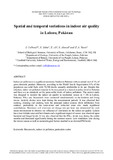JavaScript is disabled for your browser. Some features of this site may not work without it.
| dc.contributor.author | Colbeck, Ian | |
| dc.contributor.author | Sidra, S. | |
| dc.contributor.author | Ali, Z. | |
| dc.contributor.author | Ahmed, S. | |
| dc.contributor.author | Nasir, Zaheer A. | |
| dc.date.accessioned | 2019-09-05T18:02:04Z | |
| dc.date.available | 2019-09-05T18:02:04Z | |
| dc.date.issued | 2018-05-21 | |
| dc.identifier.citation | Colbeck I, Sidra S, Ali Z, et al., Spatial and temporal variations in indoor air quality in Lahore, Pakistan. International Journal of Environmental Science and Technology, June 2019, Volume 16, Issue 6, pp. 2565–2572 | en_UK |
| dc.identifier.issn | 1735-2630 | |
| dc.identifier.uri | https://doi.org/10.1007/s13762-018-1693-z | |
| dc.identifier.uri | http://dspace.lib.cranfield.ac.uk/handle/1826/14517 | |
| dc.description.abstract | Indoor air pollution is a significant economic burden in Pakistan with an annual cost of 1% of gross domestic product. Moreover, according to the World Health Organization 81% of the population use solid fuels with 70,700 deaths annually attributable to its use. Despite this situation, indoor air pollution remains to be recognized as a hazard at policy level in Pakistan and there are no standards set for permissible levels of indoor pollutants. The current study was designed to monitor the indoor air quality in residential houses (n = 30) in Lahore, Pakistan. PM2.5 and bioaerosols were monitored simultaneously in the kitchens and living rooms. Activity diaries were kept during the measurement periods. It was observed that cooking, cleaning and smoking were the principal indoor sources while infiltration from outdoors, particularly in the semi-urban and industrial areas, also made significant contributions. Maximum and minimum air change rate per hour was determined for each microenvironment to observe the influence of ventilation on indoor air quality. Lahore has a low-latitude semi-arid hot climate, and a significant impact of season was observed upon bacterial and fungal levels. It was also observed that the PM2.5 levels rose during the colder months and decreased significantly during the summer season. Low ventilation rates during the winter season as well as meteorological factors resulted in elevated PM levels. | en_UK |
| dc.language.iso | en | en_UK |
| dc.publisher | Springer | en_UK |
| dc.rights | Attribution-NonCommercial 4.0 International | * |
| dc.rights.uri | http://creativecommons.org/licenses/by-nc/4.0/ | * |
| dc.subject | Bioaerosols | en_UK |
| dc.subject | Indoor air pollution | en_UK |
| dc.subject | Particulate matter | en_UK |
| dc.title | Spatial and temporal variations in indoor air quality in Lahore, Pakistan | en_UK |
| dc.type | Article | en_UK |
Files in this item
The following license files are associated with this item:
This item appears in the following Collection(s)
-
Staff publications (SWEE) [2827]

